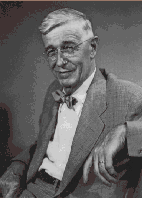Many people mistakenly believe that the mouse was invented by Apple. Others believe that Steve Jobs stole the idea from Xerox, where the mouse was used on an early office PC called the Star. But in truth, the mouse was first conceived of by Doug Engelbart in the early 1960抯, then a scientist at the Stanford Research Institute, in Menlo Park, California. SuperKids recently visited with Doug in the offices of his current venture, Bootstrap, Inc.
SuperKids: What were you working on when you came up with the idea for the mouse? Was it a project specifically aimed at developing an input device for computers?
Augmenting human intellect?
Yes. I have always believed that the complexity of the problems facing mankind is growing faster than our ability to solve them. Therefore, finding ways to augment our intellect would seem to be both a necessary and a desirable goal. At the time of the invention of the mouse, I had already been exploring possible ways for people to increase their capability to solve complex problems for more than a dozen years.
Where did the need for a mouse fit in this project?
We envisioned problem-solvers using computer-aided working stations to augment their efforts. They required the ability to interact with information displays using some sort of device to move [a cursor] around the screen. There were several devices then in use, or being considered for use: the light pen, joysticks, etc.
Why didn抰 you just use one of those?
We were looking for the best -- the most efficient -- device. We approached NASA in 1966, and said, 搇et抯 test them,� and determine the answer once-and-for-all. With NASA funding, the team developed a set of simple tasks, and timed a group of volunteers in doing those tasks with the various devices. For example, the computer would generate an object in a random position on the screen, and a cursor somewhere else. We timed how long it took the users to move the cursor to the object. It quickly became clear that the mouse out-performed all the others. Devices like the light pen simply took too much time, by repeatedly requiring the user to pick up the pointer, and reach all the way to the screen -- very tiresome.
The paper you and Bill English published in early 1967 discussing this test also referred to a 搆nee-control� device that appeared promising...
That device was based on my observation that the human foot was a pretty sensitive controller of the gas pedal in cars. With a little work, we discovered that the knee offered even better control at slight movements in all directions. In tests, it outperformed the mouse by a small margin.
Did NASA agree with your findings?
Well, the mouse had the problem of floating away in zero-gravity situations...
How did you happen to invent the mouse? Did you simply wake up one day, and say, 搕oday I shall invent the mouse�?
The actual invention of the mouse was the result of analyzing the various characteristics of other pointing/input devices. Much as the Periodic Table of the Elements has characteristics which define groups along rows and columns, we laid out a grid of existing devices. And just as the periodic table抯 rules have led to the discovery of certain previously unknown elements, this grid ultimately defined the desirable characteristics of a device that didn抰 exist. That device was the mouse.
Did you build that first mouse yourself?
No - the hardware design was done by a fellow named Bill English. Bill was an extremely effective guy. He had been working in another lab at SRI, and we were lucky he was free when this project came up. He wasn抰 afraid to dive into anything! Later on, we were joined by Jeff Rulifson, who made a big difference, really a step function improvement, in the quality of the software involved.
How did that mouse compare to today抯 devices?
The original mouse had the cord in front, but we quickly moved it to the back end to get it out of the way. It was a simple mechanical device with two perpendicularly mounted discs on the bottom. You could tilt or rock the mouse to draw perfectly straight horizontal or vertical lines.

Or you could give the mouse a push and lift it off the desk, and watch the cursor continue moving while the disc was spinning. Most of today抯 mice are still mechanical, and have modified that original design by incorporating a round ball in their base, whose movements are tracked by two orthogonally mounted disks. (You can click on the photo to see a higher resolution version photograph of the original mouse - 70k gif)
Who coined the term mouse?
[Laughs] No one can remember. It just looked like a mouse with a tail, and we all called it that in the lab.
Did you all see this as a common computer component in the future?
Yes!
Do you see the mouse remaining as ubiquitous as it is today, or will it be superseded by something else, perhaps trackballs, touchscreens, or voice recognition?
I don抰 see anything today that will beat the mouse in efficiency. But who knows? When the first touchscreens came out, we all laughed, because we knew they suffered the same problems as light pens for general purpose tasks - they just require too much wasted motion by the user. Voice recognition? I don抰 see how you can effectively move an object on a screen with voice recognition. How would it work, would you say 搖p one pixel, now over two pixels to the right?�
Did you patent it and become fabulously wealthy?
SRI patented it, but they really had no idea of its value. Some years later I learned that they had licensed it to Apple for something like $40,000.
Ouch!
What led you to working on this project at SRI to augment the human intellect?
In 1951 I was an electrical engineer at Ames Laboratories [ed. note: now NASA Ames in Sunnyvale, California). I had read a number of articles about the potential of computers, like Vannevar Bush抯 piece in the Atlantic Monthly about a personal computing device he called 搈emex�, and a book about computers called 揋iant Brains" (Giant Brains, or Machines That Think by Edmund C Berkeley), and it seemed like they opened up a whole new path of knowledge work. So after several months of thought, I decided they would make a good lifetime focus.
Were you working with computers at Ames in 1951?
No! The closest computer was somewhere on the east coast.
I left Ames to attend the University of California and received a Ph.D., and taught there for a year. But you can imagine how my ideas of augmenting the human intellect were received in 1960! [laughs] One of my colleagues on the faculty at Cal took me aside and said, 揝on, promotions in academic institutions are based on peer input. People always prefer those who share their views. If you continue on your present path, you will be an acting associate professor forever.�
So I contacted the Dean of the School of Engineering at Stanford, just across the bay from Berkeley, and received a nice letter that said something like, 揇ear Dr. Engelbart. Thank you for your interest in Stanford. Unfortunately, our School of Engineering is a small department, and we have chosen to focus only on those areas which we feel offer real potential. Since computers are only useful to service entities, we have no interest in developing a focus in them. Best of luck, etc.�
Wow - I can't believe they were so myopic! It's hard to believe that an institution so closely allied with the birth of Silicon Valley could have missed that one...
They weren't alone! I also spoke with David Packard (of Hewlett-Packard). We had a great conversation, and I was all set to work for them. Then, as I was driving home from the interview, a question forced its way into my mind. About a quarter of the way home, I stopped and called the vice president of engineering at HP I was going to work for, and asked, 揑 assume HP is planning on going into digital instruments and digital computers, and I抣l get a chance to work in those areas, right?� And he replied that they didn抰 think there was much potential there, so the answer was no.
As a result, I ended up at the Stanford Research Institute, where I was able to pursue my goal of developing systems approaches to augment the human intellect, for many years. By the end of 1968, we had not only developed the mouse, but also such things as hypertext (ed. note: that抯 the basis for the links that make the World Wide Web so popular today), dynamic on-screen editing, and video-conferencing.
